Non-Destructive Detection of Different Pesticide Residues on the Surface of Hami Melon Classification Based on tHBA-ELM Algorithm and SWIR Hyperspectral Imaging
Abstract
1. Introduction
2. Materials and Methods
2.1. Samples Preparation
2.2. Hyperspectral Imaging Acquisition and ROI Spectrum Acquisition
2.2.1. Hyperspectral Imaging System
2.2.2. Imaging Acquisition and Calibration
2.2.3. ROI Spectrum Acquisition
2.3. Spectral Data Preprocessing
2.4. Establishment of tHBA-ELM Model
2.4.1. Honey Badger Algorithm
2.4.2. Honey Badger Algorithm Based on Adaptive t-Distribution Mutation Strategy
- (1)
- Determine the tHBA algorithm parameters (population size N, mutation ratio, etc.), using Equation (3) to initialize the population.
- (2)
- Define smell intensity of prey I. Strength and prey concentration are related to the distance between it and the badger. If the smell intensity is strong, the exercise speed is higher, and the reverse is also true, as defined by Equation (4).
- (3)
- Update density factor (). The value of the decays with the increase in the number of iterations to ensure the stability of the overall environment when the algorithm transitions from the exploration state to the exploitation state, as in Equation (5).
- (4)
- Escape from local optimum and update the agents’ positions. HBA uses a sign F (F: is a sign to change the agent’s search direction.) to change the search direction to take advantage of the high opportunity for agents to scan the search space strictly. The HBA location update process is separated into two modes: “digging” and “honey”.
- (5)
- Generate the random number rand between the interval of 0 to 1. If rand < P (P: mutation probability) then according to Equation (2) adaptive t-distribution mutation, calculate the fitness value and update the badger position.
- (6)
- When the number of iterations exceeds , the optimization process will terminate and output the global optimal position, namely the optimal values of (connection weight between input layer and hidden layer) and (neuron threshold of hidden layer) in ELM.
2.4.3. ELM Classification Model Based on tHBA Optimization
- (1)
- Input the preprocessed spectral data of Hami melon samples and divide the data into training set and test set according to the ratio of 3:1, with 600 spectra in training set and 200 spectra in test set. Then the training set was used as the training sample of tHBA-ELM model, and the test set was used as the model verification.
- (2)
- The position of the badger was updated by tHBA and assigned to and in ELM. The ELM model was trained by using the and obtained from each update.
- (3)
- Set the number of iterations to 300. When the number of iterations reached 300, tHBA output the best fitness value corresponding to the badger position, using the best ω and to establish the best ELM model, and output the model results.
2.5. Assessment Standard of Models
3. Results
3.1. Spectral Characteristics of Pesticide Residues
3.2. Establishment and Analysis of Classical Machine Learning Classification Model
3.3. Comparative Analysis of Spectral Preprocessing Treatments
3.4. Establishment and Analysis of tHBA-ELM Models
4. Discussion
5. Conclusions
Author Contributions
Funding
Data Availability Statement
Acknowledgments
Conflicts of Interest
References
- Wei, K.; Zhou, X.; Yan, Q.; Tao, Y.; Wang, C. Risk Assessment of Pesticide Residues in Muskmelon in Xinjiang. Food Mach. 2019, 35, 90–95. [Google Scholar] [CrossRef]
- Dalcin, M.S.; Tschoeke, P.H.; de Souza Carlos Mourao, D.; Arguelles Osorio, P.R.; de Sousa Aguiar, R.W.; Cangussu, A.S.R.; dos Santos, G.R. Disease Progression and Productivity of Melon Plants with Different Cultural Management Techniques. J. Plant Physiol. Pathol. 2018, 5, 1–6. [Google Scholar] [CrossRef]
- Food and Agriculture Organization of the United Nations. International Code of Conduct on the Distribution and Use of Pesticides; FAO: Rome, Italy, 2003. [Google Scholar]
- Yazici, A.; Tiryaki, G.Y.; Ayvaz, H. Determination of Pesticide Residual Levels in Strawberry (Fragaria) by near-Infrared Spectroscopy. J. Sci. Food Agric. 2020, 100, 1980–1989. [Google Scholar] [CrossRef]
- Tao, Y.; Dong, F.; Xu, J.; Liu, X.; Cheng, Y.; Liu, N.; Chen, Z.; Zheng, Y. Green and Sensitive Supercritical Fluid Chromatographic-Tandem Mass Spectrometric Method for the Separation and Determination of Flutriafol Enantiomers in Vegetables, Fruits, and Soil. J. Agric. Food Chem. 2014, 62, 11457–11464. [Google Scholar] [CrossRef] [PubMed]
- Wang, X.; Tang, Q.; Wang, Q.; Qiao, X.; Xu, Z. Study of a Molecularly Imprinted Solid-Phase Extraction Coupled with High-Performance Liquid Chromatography for Simultaneous Determination of Trace Trichlorfon and Monocrotophos Residues in Vegetables. J. Sci. Food Agric. 2014, 94, 1409–1415. [Google Scholar] [CrossRef]
- Garcia-Febrero, R.; Salvador, J.P.; Sanchez-Baeza, F.; Marco, M.P. Rapid Method Based on Immunoassay for Determination of Paraquat Residues in Wheat, Barley and Potato. Food Control 2014, 41, 193–201. [Google Scholar] [CrossRef]
- Campillo, N.; Viñas, P.; Férez-Melgarejo, G.; Hernández-Córdoba, M. Liquid Chromatography with Diode Array Detection and Tandem Mass Spectrometry for the Determination of Neonicotinoid Insecticides in Honey Samples Using Dispersive Liquid-Liquid Microextraction. J. Agric. Food Chem. 2013, 61, 4799–4805. [Google Scholar] [CrossRef] [PubMed]
- Soltani Firouz, M.; Sardari, H. Defect Detection in Fruit and Vegetables by Using Machine Vision Systems and Image Processing. Food Eng. Rev. 2022, 14, 353–379. [Google Scholar] [CrossRef]
- Sanaeifar, A.; Li, X.; He, Y.; Huang, Z.; Zhan, Z. A Data Fusion Approach on Confocal Raman Microspectroscopy and Electronic Nose for Quantitative Evaluation of Pesticide Residue in Tea. Biosyst. Eng. 2021, 210, 206–222. [Google Scholar] [CrossRef]
- Zhao, K.; Zha, Z.; Li, H.; Wu, J. Early Detection of Moldy Apple Core Using Symmetrized Dot Pattern Images of Vibro-Acoustic Signals. Trans. Chin. Soc. Agric. Eng. 2021, 37, 290–298. [Google Scholar] [CrossRef]
- Chen, S.; Zhao, Q.; Dong, D. Application of near Infrared Spectroscopy Combined with Comparative Principal Component Analysis for Pesticide Residue Detection in Fruit. Spectrosc. Spectr. Anal. 2020, 40, 917–921. [Google Scholar]
- Xia, J.; Xu, W.; Li, Y.; Li, G.; Wang, X.; Xiong, Y.; Min, S. Quality Control of Pesticide Using Infrared Spectroscopic Coupled with Fingerprint Analysis. Infrared Phys. Technol. 2022, 122, 2–8. [Google Scholar] [CrossRef]
- Yu, G.; Ma, B.; Chen, J.; Li, X.; Li, Y.; Li, C. Nondestructive Identification of Pesticide Residues on the Hami Melon Surface Using Deep Feature Fusion by Vis/NIR Spectroscopy and 1D-CNN. J. Food Process Eng. 2021, 44, e13602. [Google Scholar] [CrossRef]
- Ma, S.; Ji, R.; Wang, X.; Yu, C.; Yu, Y.; Yang, X. Fluorescence Detection of Boscalid Pesticide Residues in Grape Juice. Optik 2019, 180, 236–239. [Google Scholar] [CrossRef]
- Hu, J.; Zou, Y.; Sun, B.; Yu, X.; Shang, Z.; Huang, J.; Jin, S.; Liang, P. Raman Spectrum Classification Based on Transfer Learning by a Convolutional Neural Network: Application to Pesticide Detection. Spectrochim. Acta Part A Mol. Biomol. Spectrosc. 2022, 265, 120366. [Google Scholar] [CrossRef] [PubMed]
- Ma, Q.; Teng, Y.; Li, C.; Jiang, L. Simultaneous Quantitative Determination of Low-Concentration Ternary Pesticide Mixtures in Wheat Flour Based on Terahertz Spectroscopy and BPNN. Food Chem. 2022, 377, 132030. [Google Scholar] [CrossRef]
- López-Maestresalas, A.; Keresztes, J.C.; Goodarzi, M.; Arazuri, S.; Jarén, C.; Saeys, W. Non-Destructive Detection of Blackspot in Potatoes by Vis-NIR and SWIR Hyperspectral Imaging. Food Control 2016, 70, 229–241. [Google Scholar] [CrossRef]
- Sellami, A.; Tabbone, S. Deep Neural Networks-Based Relevant Latent Representation Learning for Hyperspectral Image Classification. Pattern Recognit. 2022, 121, 108224. [Google Scholar] [CrossRef]
- Wang, Z.; Fan, S.; Wu, J.; Zhang, C.; Xu, F.; Yang, X.; Li, J. Application of Long-Wave near Infrared Hyperspectral Imaging for Determination of Moisture Content of Single Maize Seed. Spectrochim. Acta Part A Mol. Biomol. Spectrosc. 2021, 254, 119666. [Google Scholar] [CrossRef]
- Li, Y.; Ma, B.; Li, C.; Yu, G. Accurate Prediction of Soluble Solid Content in Dried Hami Jujube Using SWIR Hyperspectral Imaging with Comparative Analysis of Models. Comput. Electron. Agric. 2022, 193, 106655. [Google Scholar] [CrossRef]
- Song, H.; Yang, W.; Yuan, H.; Bufford, H. Deep 3d-Multiscale Densenet for Hyperspectral Image Classification Based on Spatial-Spectral Information. Intell. Autom. Soft Comput. 2020, 26, 1441–1458. [Google Scholar] [CrossRef]
- Alimohammadi, F.; Rasekh, M.; Sayyah, A.H.A.; Abbaspour-Gilandeh, Y.; Karami, H.; Sharabiani, V.R.; Fioravanti, A.; Gancarz, M.; Findura, P.; Kwaśniewski, D. Hyperspectral Imaging Coupled with Multivariate Analysis and Artificial Intelligence to the Classification of Maize Kernels. Int. Agrophys. 2022, 36, 83–91. [Google Scholar] [CrossRef]
- Zhang, H.; Zhang, S.; Dong, W.; Luo, W.; Huang, Y.; Zhan, B.; Liu, X. Detection of Common Defects on Mandarins by Using Visible and near Infrared Hyperspectral Imaging. Infrared Phys. Technol. 2020, 108, 103341. [Google Scholar] [CrossRef]
- Liu, Z.; Jiang, J.; Du, Y.; Xu, Z. A Band Influence Algorithm for Hyperspectral Band Selection to Classify Moldy Peanuts. IEEE Access 2021, 9, 147527–147536. [Google Scholar] [CrossRef]
- Using, A.; Hyperspectral, P.N.I.R.; Ekramirad, N.; Khaled, A.Y.; Doyle, L.E.; Loeb, J.R.; Donohue, K.D.; Villanueva, R.T.; Adedeji, A.A. Nondestructive Detection of Codling Moth Infestation in Machine Learning and Feature Selection. Foods 2022, 11, 8. [Google Scholar]
- Lee, H.; Kim, M.S.; Lim, H.S.; Park, E.; Lee, W.H.; Cho, B.K. Detection of Cucumber Green Mottle Mosaic Virus-Infected Watermelon Seeds Using a near-Infrared (NIR) Hyperspectral Imaging System: Application to Seeds of the “Sambok Honey” Cultivar. Biosyst. Eng. 2016, 148, 138–147. [Google Scholar] [CrossRef]
- Jun, S.; Shuying, J.; Meixia, Z.; Hanping, M.; Xiaohong, W.; Qinglin, L. Detection of Pesticide Residues in Mulberey Leaves Using Vis-Nir Hyperspectral Imaging Technology. J. Residuals Sci. Technol. 2016, 13, S125–S131. [Google Scholar] [CrossRef]
- Sun, J.; Cong, S.; Mao, H.; Wu, X.; Yang, N. Quantitative Detection of Mixed Pesticide Residue of Lettuce Leaves Based on Hyperspectral Technique. J. Food Process Eng. 2018, 41, e12654. [Google Scholar] [CrossRef]
- Su, W.H.; Sun, D.W.; He, J.G.; Zhang, L.B. Variation Analysis in Spectral Indices of Volatile Chlorpyrifos and Non-Volatile Imidacloprid in Jujube (Ziziphus jujuba Mill.) Using near-Infrared Hyperspectral Imaging (NIR-HSI) and Gas Chromatograph-Mass Spectrometry (GC–MS). Comput. Electron. Agric. 2017, 139, 41–55. [Google Scholar] [CrossRef]
- Nturambirwe, J.F.I.; Perold, W.J.; Opara, U.L. Classification Learning of Latent Bruise Damage to Apples Using Shortwave Infrared Hyperspectral Imaging. Sensors 2021, 21, 4990. [Google Scholar] [CrossRef]
- Qi, X.; Jiang, J.; Cui, X.; Yuan, D. Moldy Peanut Kernel Identification Using Wavelet Spectral Features Extracted from Hyperspectral Images. Food Anal. Methods 2020, 13, 445–456. [Google Scholar] [CrossRef]
- Xu, Y.; Zhang, H.; Zhang, C.; Wu, P.; Li, J.; Xia, Y.; Fan, S. Rapid Prediction and Visualization of Moisture Content in Single Cucumber (Cucumis sativus L.) Seed Using Hyperspectral Imaging Technology. Infrared Phys. Technol. 2019, 102, 103034. [Google Scholar] [CrossRef]
- Li, B.; Cobo-Medina, M.; Lecourt, J.; Harrison, N.B.; Harrison, R.J.; Cross, J.V. Application of Hyperspectral Imaging for Nondestructive Measurement of Plum Quality Attributes. Postharvest Biol. Technol. 2018, 141, 8–15. [Google Scholar] [CrossRef]
- Cen, H.; He, Y. Theory and Application of near Infrared Reflectance Spectroscopy in Determination of Food Quality. Trends Food Sci. Technol. 2007, 18, 72–83. [Google Scholar] [CrossRef]
- Malvandi, A.; Kapoor, R.; Feng, H.; Kamruzzaman, M. Non-Destructive Measurement and Real-Time Monitoring of Apple Hardness during Ultrasonic Contact Drying via Portable NIR Spectroscopy and Machine Learning. Infrared Phys. Technol. 2022, 122, 104077. [Google Scholar] [CrossRef]
- Yang, Y.; Zhao, C.; Huang, W.; Tian, X.; Fan, S.; Wang, Q.; Li, J. Optimization and Compensation of Models on Tomato Soluble Solids Content Assessment with Online Vis/NIRS Diffuse Transmission System. Infrared Phys. Technol. 2022, 121, 104050. [Google Scholar] [CrossRef]
- Wang, W.; Ma, B.; Luo, X.; Li, X.; Lei, S.; Li, Y.; Sun, J. Study on the Moisture Content of Dried Hami Big Jujubes by Near-Infrared Spectroscopy Combined with Variable Preferred and GA-ELM Model. Spectrosc. Spectr. Anal. 2020, 40, 543–549. [Google Scholar]
- Cong, S.; Liu, C.; Zhu, Z.; Hu, A. Study on Identification of Multiple Pesticide Residues in Lettuce Leaves Based on Hyperspectral Technology. Commun. Comput. Inf. Sci. 2021, 1424, 537–550. [Google Scholar] [CrossRef]
- Pu, H.; Liu, D.; Wang, L.; Sun, D.W. Soluble Solids Content and PH Prediction and Maturity Discrimination of Lychee Fruits Using Visible and near Infrared Hyperspectral Imaging. Food Anal. Methods 2016, 9, 235–244. [Google Scholar] [CrossRef]
- Sunli, C.; Jun, S.; Hanping, M.; Xiaohong, W.; Pei, W.; Xiaodong, Z. Non-Destructive Detection for Mold Colonies in Rice Based on Hyperspectra and GWO-SVR. J. Sci. Food Agric. 2018, 98, 1453–1459. [Google Scholar] [CrossRef]
- Bonah, E.; Huang, X.; Yi, R.; Aheto, J.H.; Yu, S. Vis-NIR Hyperspectral Imaging for the Classification of Bacterial Foodborne Pathogens Based on Pixel-Wise Analysis and a Novel CARS-PSO-SVM Model. Infrared Phys. Technol. 2020, 105, 103220. [Google Scholar] [CrossRef]
- Sun, J.; Ge, X.; Wu, X.; Dai, C.; Yang, N. Identification of Pesticide Residues in Lettuce Leaves Based on near Infrared Transmission Spectroscopy. J. Food Process Eng. 2018, 41, e12816. [Google Scholar] [CrossRef]
- Xu, L.; Zhou, Y.P.; Tang, L.J.; Wu, H.L.; Jiang, J.H.; Shen, G.L.; Yu, R.Q. Ensemble Preprocessing of Near-Infrared (NIR) Spectra for Multivariate Calibration. Anal. Chim. Acta 2008, 616, 138–143. [Google Scholar] [CrossRef] [PubMed]
- Isaksson, T.; Naes, T. Effect of Multiplicative Scatter Correction (MSC) and Linearity Improvement in NIR Spectroscopy. Appl. Spectrosc. 1988, 42, 1273–1284. [Google Scholar] [CrossRef]
- Stordrange, L.; Libnau, F.O.; Malthe-Sørenssen, D.; Kvalheim, O.M. Feasibility Study of NIR for Surveillance of a Pharmaceutical Process, Including a Study of Different Preprocessing Techniques. J. Chemom. 2002, 16, 529–541. [Google Scholar] [CrossRef]
- Rinnan, Å.; van den Berg, F.; Engelsen, S.B. Review of the Most Common Pre-Processing Techniques for near-Infrared Spectra. Trends Anal. Chem. 2009, 28, 1201–1222. [Google Scholar] [CrossRef]
- Hashim, F.A.; Houssein, E.H.; Hussain, K.; Mabrouk, M.S.; Al-Atabany, W. Honey Badger Algorithm: New Metaheuristic Algorithm for Solving Optimization Problems. Math. Comput. Simul. 2022, 192, 84–110. [Google Scholar] [CrossRef]
- Yin, S.; Luo, Q.; Du, Y.; Zhou, Y. DTSMA: Dominant Swarm with Adaptive T-Distribution Mutation-Based Slime Mould Algorithm. Math. Biosci. Eng. 2022, 19, 2240–2285. [Google Scholar] [CrossRef]
- Li, J.; Tian, X.; Huang, W.; Zhang, B.; Fan, S. Application of Long-Wave near Infrared Hyperspectral Imaging for Measurement of Soluble Solid Sontent (SSC) in Pear. Food Anal. Methods 2016, 9, 3087–3098. [Google Scholar] [CrossRef]
- He, W.; He, H.; Wang, F.; Wang, S.; Lyu, R. Non-Destructive Detection and Recognition of Pesticide Residues on Garlic Chive (Allium tuberosum) Leaves Based on Short Wave Infrared Hyperspectral Imaging and One-Dimensional Convolutional Neural Network. J. Food Meas. Charact. 2021, 15, 4497–4507. [Google Scholar] [CrossRef]
- Dong, J.; Guo, W. Nondestructive Determination of Apple Internal Qualities Using Near-Infrared Hyperspectral Reflectance Imaging. Food Anal. Methods 2015, 8, 2635–2646. [Google Scholar] [CrossRef]
- Sun, J.; Zhou, X.; Mao, H.P.; Wu, X.H.; Zhang, X.D.; Gao, H.Y. Identification of Pesticide Residue Level in Lettuce Based on Hyperspectra and Chlorophyll Fluorescence Spectra. Int. J. Agric. Biol. Eng. 2016, 9, 231–239. [Google Scholar] [CrossRef]
- Siedliska, A.; Baranowski, P.; Zubik, M.; Mazurek, W.; Sosnowska, B. Detection of Fungal Infections in Strawberry Fruit by VNIR/SWIR Hyperspectral Imaging. Postharvest Biol. Technol. 2018, 139, 115–126. [Google Scholar] [CrossRef]
- Manley, M.; du Toit, G.; Geladi, P. Tracking Diffusion of Conditioning Water in Single Wheat Kernels of Different Hardnesses by near Infrared Hyperspectral Imaging. Anal. Chim. Acta 2011, 686, 64–75. [Google Scholar] [CrossRef] [PubMed]
- Sun, J.; Zhou, X.; Mao, H.; Wu, X.; Yang, N.; Zhang, X. Detection of Pesticide Residues on Lettuce Leaves Based on Piece-Wise Discrete Wavelet Transform and Hyperspectral Data. Nongye Jixie Xuebao/Trans. Chin. Soc. Agric. Mach. 2016, 47, 323–329. [Google Scholar] [CrossRef]
- Li, C.; Ge, X.; Jin, Y.; Sun, J. Detection of Pesticide Residues in Vegetables Based on Near-Infrared Spectroscopy. Agric. Eng. 2019, 9, 33–39. [Google Scholar] [CrossRef]
- Song, D.; Gao, D.; Sun, H.; Qiao, L.; Zhao, R.; Tang, W.; Li, M. Chlorophyll Content Estimation Based on Cascade Spectral Optimizations of Interval and Wavelength Characteristics. Comput. Electron. Agric. 2021, 189, 106413. [Google Scholar] [CrossRef]
- Nagasubramanian, K.; Jones, S.; Sarkar, S.; Singh, A.K.; Singh, A.; Ganapathysubramanian, B. Hyperspectral Band Selection Using Genetic Algorithm and Support Vector Machines for Early Identification of Charcoal Rot Disease in Soybean Stems. Plant Methods 2018, 14, 86. [Google Scholar] [CrossRef]
- Qiao, Z.; Zhan, C. Prediction of Sugar Content in Apple Based on Near-Infrared Spectroscopy of SSA-ELM. Food Mach. 2021, 37, 121–126. [Google Scholar] [CrossRef]
- Zhou, Q.; Liu, Y.; Kou, K.; Zhao, G. Study on Spectral Properties of Difenoconazole by Terahertz Time-Domain Spectroscopy. In 2015 International Conference on Optical Instruments and Technology: Terahertz Technologies and Applications; SPIE: Bellingham, WA, USA, 2015; Volume 9625, p. 962504. [Google Scholar] [CrossRef]
- Lei, Z.; Zeng, Y.; Liu, P.; Su, X. Active Deep Learning for Hyperspectral Image Classification with Uncertainty Learning. IEEE Geosci. Remote Sens. Lett. 2022, 19, 1–5. [Google Scholar] [CrossRef]
- Yuan, Y.; Wang, C.; Jiang, Z. Proxy-Based Deep Learning Framework for Spectral-Spatial Hyperspectral Image Classification: Efficient and Robust. IEEE Trans. Geosci. Remote Sens. 2022, 60, 1–15. [Google Scholar] [CrossRef]
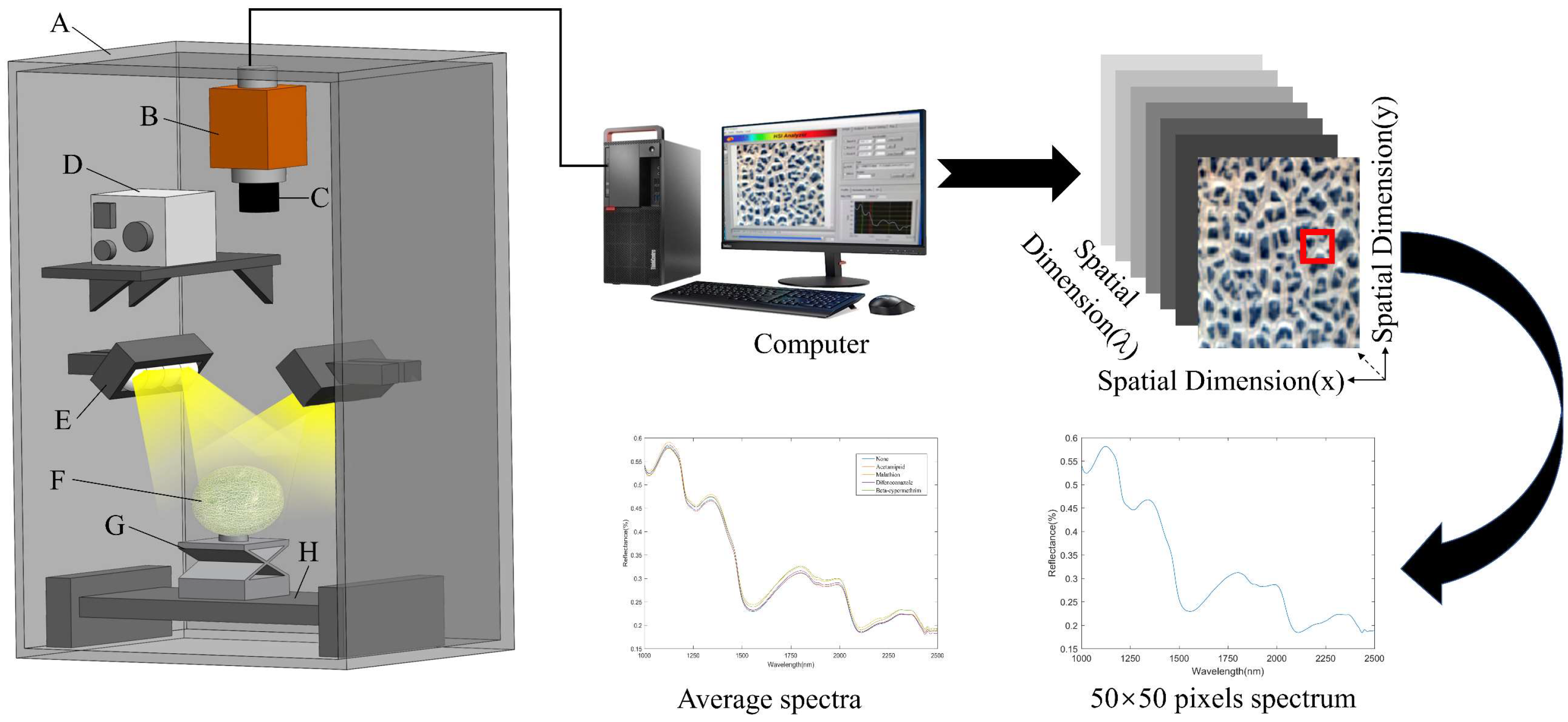
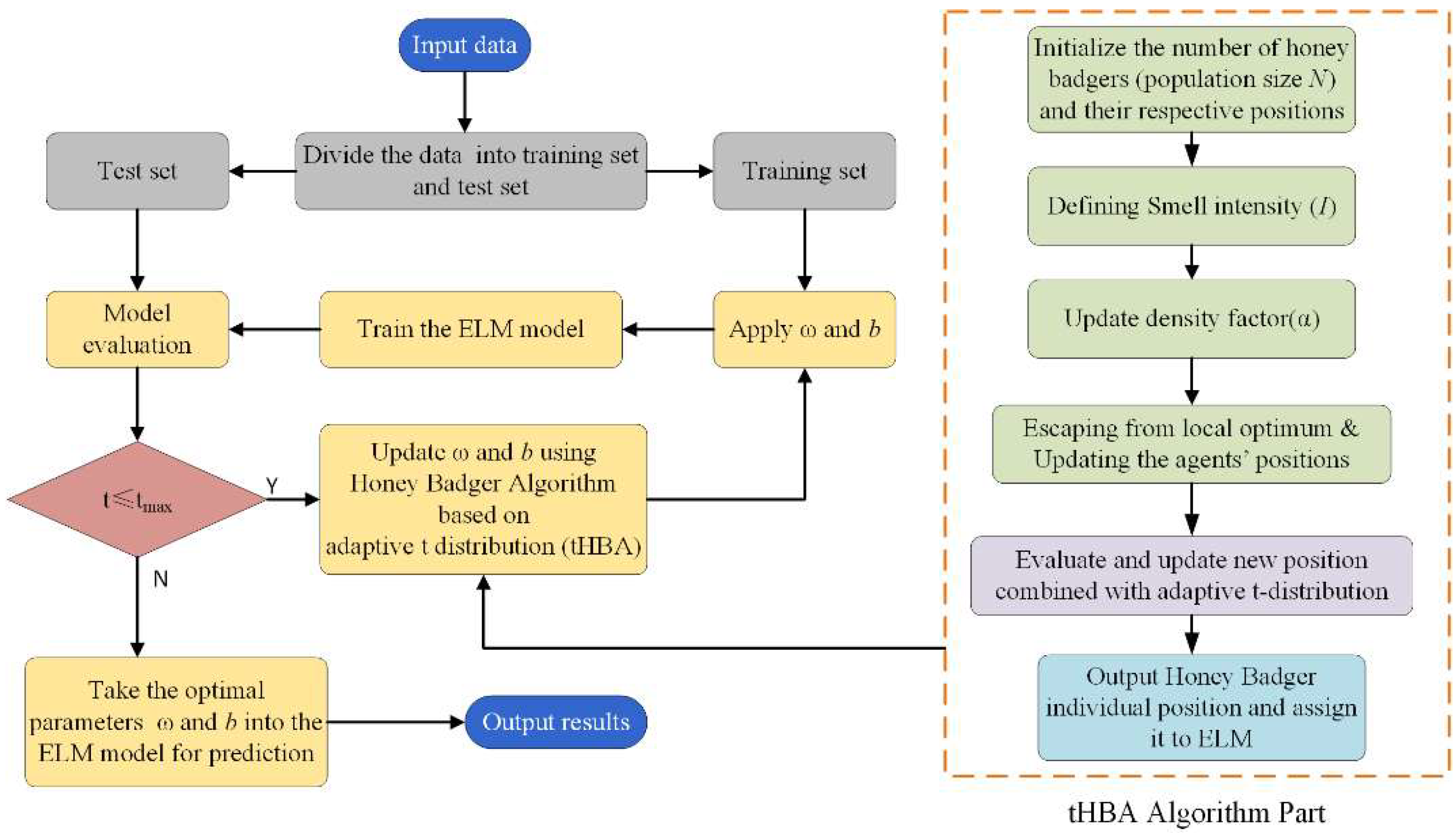
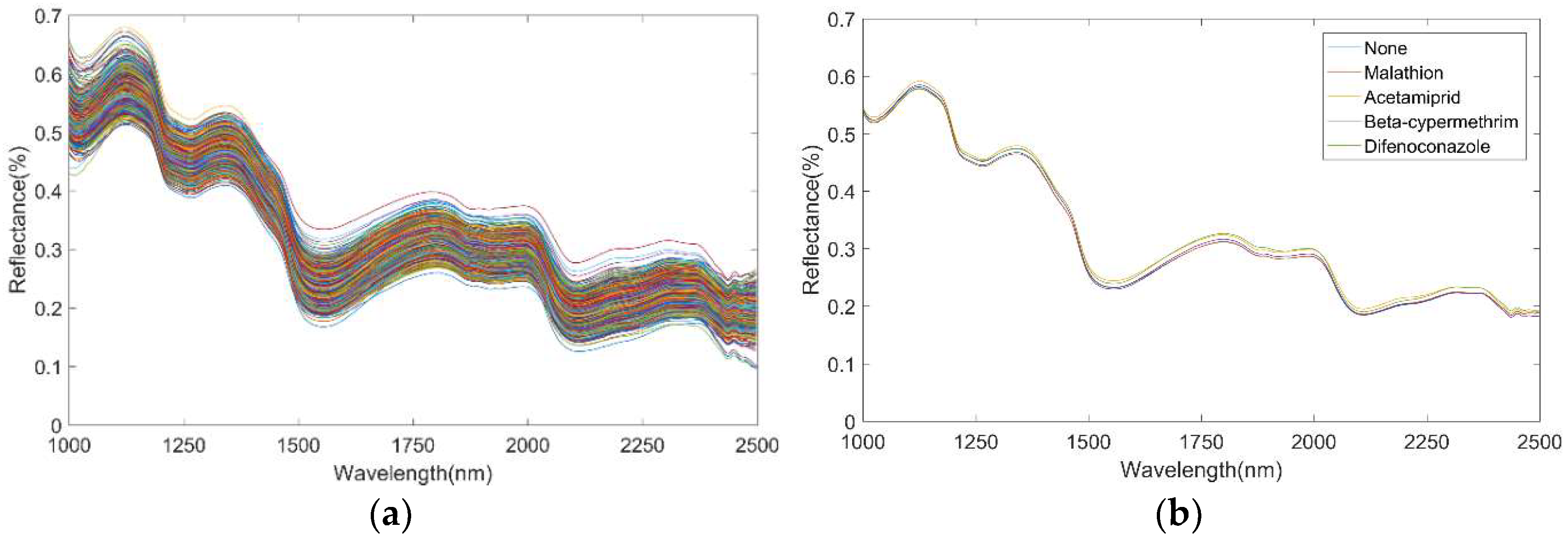
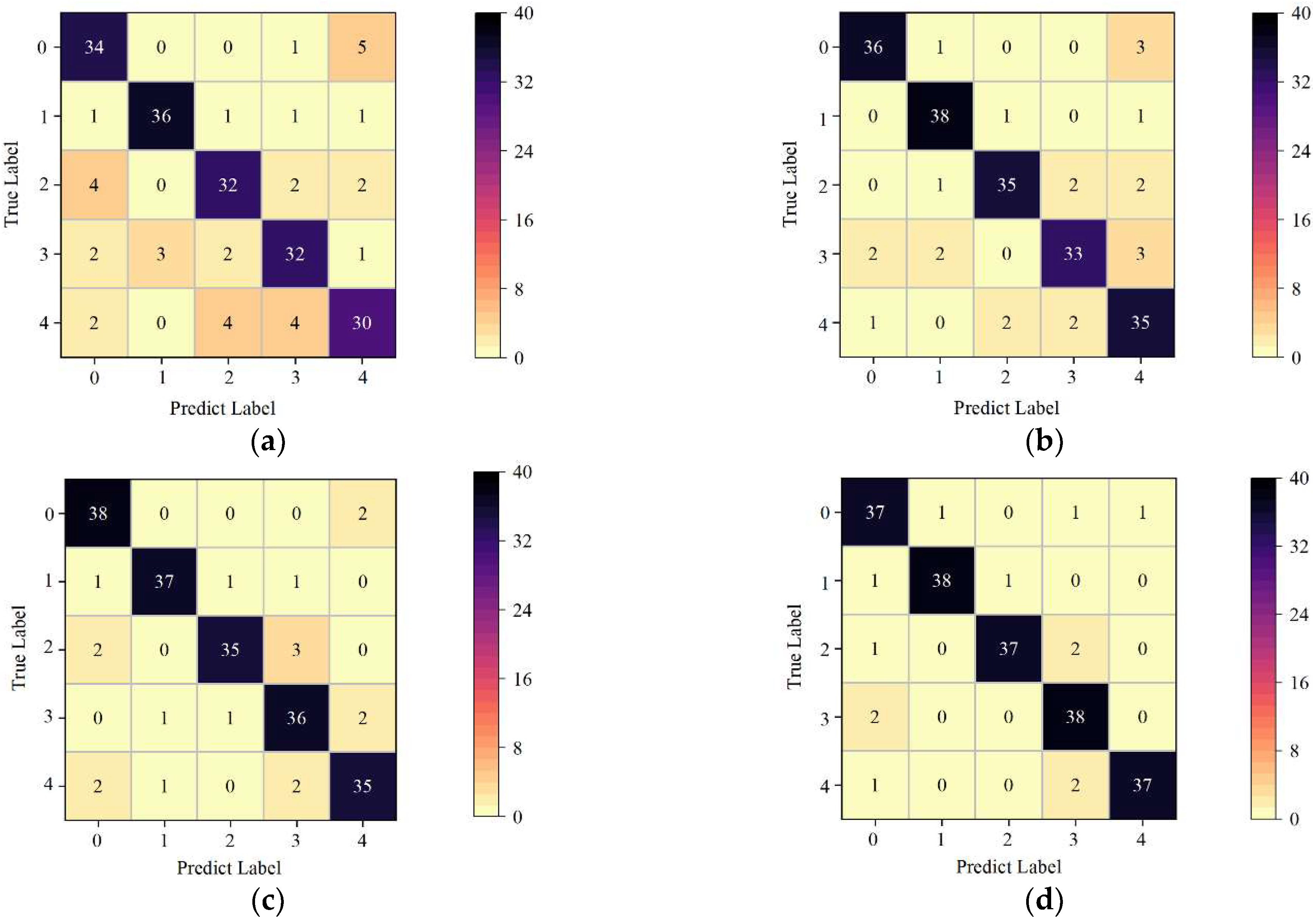
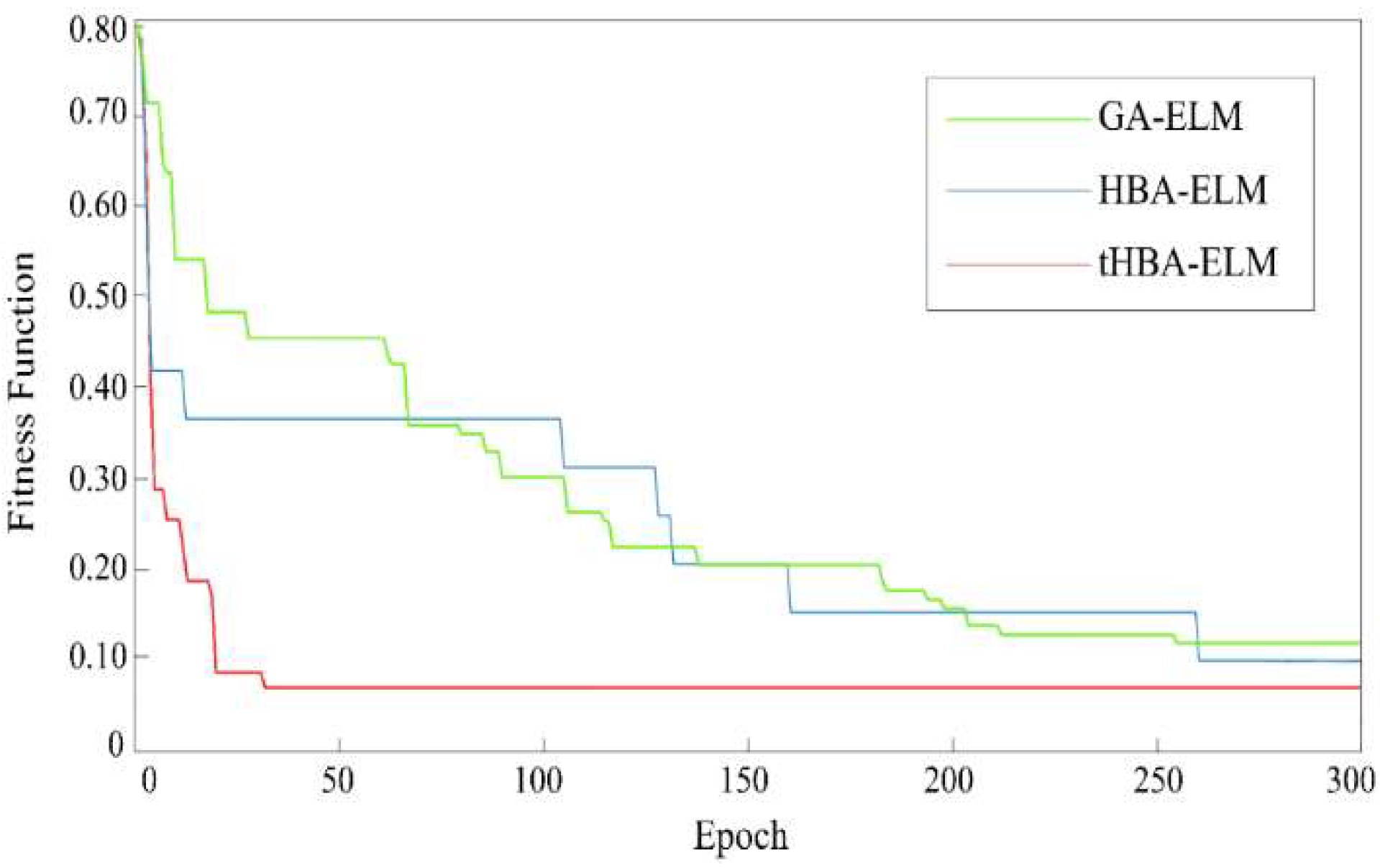
| Models | Class | Accuracy (%) | Precision (%) | Sensitivity (%) | F1-Score |
|---|---|---|---|---|---|
| ELM | All | 79.50 | 80.29 | 79.50 | 0.7962 |
| None | 75.00 | 78.95 | 75.00 | 0.7692 | |
| Acetamiprid | 82.50 | 89.19 | 82.50 | 0.8571 | |
| Malathion | 82.50 | 73.33 | 82.50 | 0.7765 | |
| Difenoconazole | 82.50 | 71.74 | 82.50 | 0.7674 | |
| Beta-cypermethrin | 75.00 | 88.24 | 75.00 | 0.8108 | |
| SVM | All | 77.50 | 78.03 | 77.50 | 0.7760 |
| None | 75.00 | 78.95 | 75.00 | 0.7692 | |
| Acetamiprid | 77.50 | 86.11 | 77.50 | 0.8158 | |
| Malathion | 75.00 | 78.95 | 75.00 | 0.7692 | |
| Difenoconazole | 80.00 | 68.09 | 80.00 | 0.7356 | |
| Beta-cypermethrin | 80.00 | 78.05 | 80.00 | 0.7901 | |
| PLS-DA | All | 75.50 | 76.42 | 75.50 | 0.7555 |
| None | 75.00 | 76.92 | 75.00 | 0.7595 | |
| Acetamiprid | 67.50 | 87.10 | 67.50 | 0.7606 | |
| Malathion | 82.50 | 71.74 | 82.50 | 0.7674 | |
| Difenoconazole | 77.50 | 67.39 | 77.50 | 0.7209 | |
| Beta-cypermethrin | 75.00 | 78.95 | 75.00 | 0.7692 |
| Models | Class | Accuracy (%) | Precision (%) | Sensitivity (%) | F1-Score |
|---|---|---|---|---|---|
| NM- ELM | All | 82.00 | 82.07 | 82.00 | 0.8201 |
| None | 85.00 | 79.07 | 85.00 | 0.8193 | |
| Acetamiprid | 90.00 | 92.31 | 90.00 | 0.9114 | |
| Malathion | 80.00 | 82.05 | 80.00 | 0.8101 | |
| Difenoconazole | 80.00 | 80.00 | 80.00 | 0.8000 | |
| Beta-cypermethrin | 75.00 | 76.92 | 75.00 | 0.7595 | |
| MSC-ELM | All | 80.50 | 80.87 | 80.50 | 0.8062 |
| None | 82.50 | 84.62 | 82.50 | 0.8354 | |
| Acetamiprid | 85.00 | 91.89 | 85.00 | 0.8831 | |
| Malathion | 82.50 | 78.57 | 82.50 | 0.8049 | |
| Difenoconazole | 75.00 | 69.77 | 75.00 | 0.7229 | |
| Beta-cypermethrin | 77.50 | 79.49 | 77.50 | 0.7848 | |
| SNV-ELM | All | 80.00 | 80.08 | 80.00 | 0.8001 |
| None | 82.50 | 84.62 | 82.50 | 0.8354 | |
| Acetamiprid | 82.50 | 84.62 | 82.50 | 0.8354 | |
| Malathion | 75.00 | 76.92 | 75.00 | 0.7595 | |
| Difenoconazole | 82.50 | 76.74 | 82.50 | 0.7952 | |
| Beta-cypermethrin | 77.50 | 77.50 | 77.50 | 0.7750 |
| Models | Class | Accuracy (%) | Precision (%) | Sensitivity (%) | F1-Score |
|---|---|---|---|---|---|
| NM- GA- ELM | All | 88.50 | 88.72 | 88.50 | 0.8852 |
| None | 90.00 | 92.31 | 90.00 | 0.9114 | |
| Acetamiprid | 95.00 | 90.48 | 95.00 | 0.9268 | |
| Malathion | 87.50 | 92.11 | 87.50 | 0.8974 | |
| Difenoconazole | 82.50 | 89.19 | 82.50 | 0.8571 | |
| Beta-cypermethrin | 87.50 | 79.55 | 87.50 | 0.8333 | |
| NM-HBA-ELM | All | 90.50 | 90.66 | 90.50 | 0.9051 |
| None | 95.00 | 88.37 | 95.00 | 0.9157 | |
| Acetamiprid | 92.50 | 94.87 | 92.50 | 0.9367 | |
| Malathion | 87.50 | 94.59 | 87.50 | 0.9091 | |
| Difenoconazole | 90.00 | 85.71 | 90.00 | 0.8780 | |
| Beta-cypermethrin | 87.50 | 89.74 | 87.50 | 0.8861 | |
| NM-tHBA-ELM | All | 93.50 | 93.73 | 93.50 | 0.9355 |
| None | 92.50 | 88.10 | 92.50 | 0.9024 | |
| Acetamiprid | 95.00 | 97.44 | 95.00 | 0.9620 | |
| Malathion | 92.50 | 97.37 | 92.50 | 0.9487 | |
| Difenoconazole | 95.00 | 88.37 | 95.00 | 0.9157 | |
| Beta-cypermethrin | 92.50 | 97.37 | 92.50 | 0.9487 |
Disclaimer/Publisher’s Note: The statements, opinions and data contained in all publications are solely those of the individual author(s) and contributor(s) and not of MDPI and/or the editor(s). MDPI and/or the editor(s) disclaim responsibility for any injury to people or property resulting from any ideas, methods, instructions or products referred to in the content. |
© 2023 by the authors. Licensee MDPI, Basel, Switzerland. This article is an open access article distributed under the terms and conditions of the Creative Commons Attribution (CC BY) license (https://creativecommons.org/licenses/by/4.0/).
Share and Cite
Hu, Y.; Ma, B.; Wang, H.; Li, Y.; Zhang, Y.; Yu, G. Non-Destructive Detection of Different Pesticide Residues on the Surface of Hami Melon Classification Based on tHBA-ELM Algorithm and SWIR Hyperspectral Imaging. Foods 2023, 12, 1773. https://doi.org/10.3390/foods12091773
Hu Y, Ma B, Wang H, Li Y, Zhang Y, Yu G. Non-Destructive Detection of Different Pesticide Residues on the Surface of Hami Melon Classification Based on tHBA-ELM Algorithm and SWIR Hyperspectral Imaging. Foods. 2023; 12(9):1773. https://doi.org/10.3390/foods12091773
Chicago/Turabian StyleHu, Yating, Benxue Ma, Huting Wang, Yujie Li, Yuanjia Zhang, and Guowei Yu. 2023. "Non-Destructive Detection of Different Pesticide Residues on the Surface of Hami Melon Classification Based on tHBA-ELM Algorithm and SWIR Hyperspectral Imaging" Foods 12, no. 9: 1773. https://doi.org/10.3390/foods12091773
APA StyleHu, Y., Ma, B., Wang, H., Li, Y., Zhang, Y., & Yu, G. (2023). Non-Destructive Detection of Different Pesticide Residues on the Surface of Hami Melon Classification Based on tHBA-ELM Algorithm and SWIR Hyperspectral Imaging. Foods, 12(9), 1773. https://doi.org/10.3390/foods12091773







